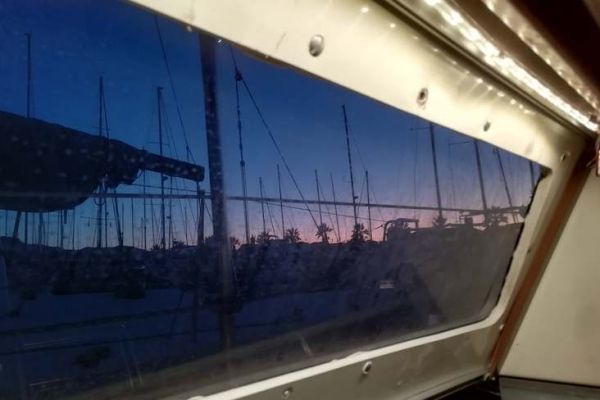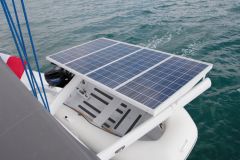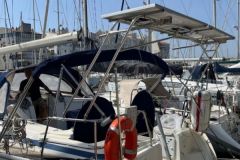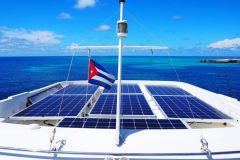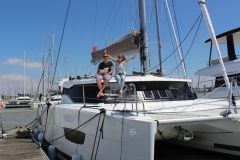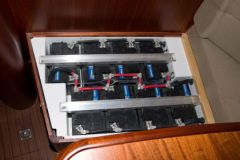Familiarization with the jargon and the electrical system
My electric adventure began at anchor. After my moving in to live aboard La Ceci i soon realized that the existing installation wasn't going to be enough. In fact, I had a small solar panel and a battery sufficient to power the anchor and navigation lights at night and the pilot during the day, but not enough to live aboard, even with fairly low consumption.
I was going to have to get on with it. I wanted to do it myself. It was a way of becoming autonomous. So I had to start by understanding how the electrical system worked, the difference between volts, watts and amperes - yes, I'd got that far - and how to connect the batteries to each other, in parallel or in series. This question brought back my techno classes... and they were far, far away. I had to understand the function of the alternator, the function of the charger, the function and power requirements of the converter, the thickness of electrical cables, direct and alternating current...
I also had to consider the difference between batteries: gel batteries, AGM, fast or slow discharge, ...? Once chosen, I had to decide on their suitability in terms of capacity - 150 Ah, 180 Ah, 260Ah - while checking that their size fitted the available space.
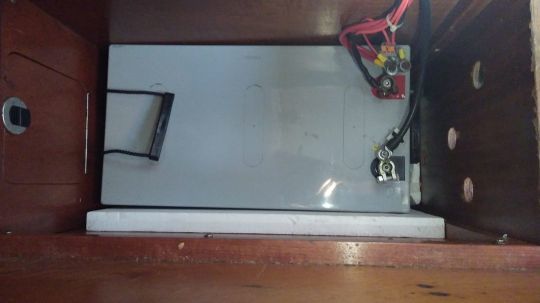
A nice little puzzle, for me anyway.
Fortunately, the sailing community around me was patient enough to explain how it all worked.
How will I generate electricity?
At that point, to say that things were clear in my head would have been to show off, but they were beginning to become so. Then came another question: How was I going to generate this electricity? Solar panels or wind turbines?
Talking about it around me and looking a bit on the net, I quickly decided in favor of panels. In fact, the fragility of wind turbines and the noise they make when they turn put me off a little. What's more, the risk of seeing them as a head-chopping weapon haunted me...
So I decided to install solar panels. Yes, but which solar panels?
This was the start of a whole process of research and comparison of existing panel types - monocrystalline, polycrystalline, amorphous? - and, depending on the load required, the definition of the combination to be made: one large panel, two small ones? All of which defined the space they would occupy.
The final decision would depend on my power consumption needs.
How much electrical power do you need to be autonomous?
To finalize the organization of this quest for autonomy, it was time to look at my own consumption and that of La Ceci. I soon realized that this questioning was directly linked to my way of life.
What do I plug in? How much do these devices consume? How much does my boat consume, with its LEDs, water pumps, radio, navigation instruments, autopilot, Webasto...?
This is a very interesting exercise.
Just as I became aware of the resources used when I arrived at the anchorage, having to take a more concrete look at the power consumption of every item used with more or less regularity on the boat was also a source of ecological awakening.
Indeed, I wanted to be as little dependent as possible on the engine to recharge my batteries, and even less on a generator (which doesn't mean that, depending on the travel schedule, I wouldn't need one). The components to be plugged into the mains therefore all had to be 12V-compatible. Coming from my apartment with a toaster, raclette machine (I love it), blender and all the other utensils you'd find in a normal kitchen, I was going to have to reinvent my kitchen without them.

I did and, you know what? Well, it feels good.
The toaster is a frying pan, the raclette machine is a frying pan on top of tea lights in another frying pan, and the blender has become a hand blender using a closed container with blades and a cord - thanks, guys! Quite an overhaul, but you get used to it pretty quickly. I even have an open fire.
What about the fridge? The outdoors in winter and, in general, a change in shopping habits. After two years, I did acquire a cooler for cold beers in summer... Yes, you're either Belgian or you're not.
Getting back to my solar panels, after this needs analysis, I concluded that I was going to need 2: monocrystalline, each 150 watts. I soon realized that I'd have to install a gantry crane.
As for the battery, I opted for a 260 Ah one. As luck would have it, this imposing 80 kg battery would fit exactly where I thought it would.
Gantry construction
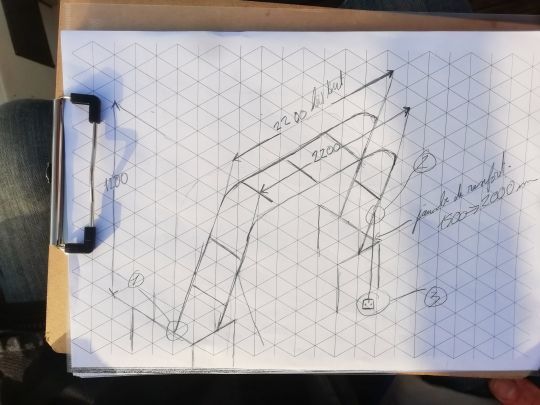
So begins the quest for the gantry. I look at the boats in port, all around me. I ask around in specialist stores, I look online. It's not easy. Logically enough, I want it to be solid and aerodynamic. I don't like the idea of making holes in the boat. I find that the ones on sale are very expensive. I came across a craftsman in Hendaye who made them to measure. I contacted him. We thought about it together.
For me, as a total novice in this electrical world, I'm gradually assimilating this information. At the same time as I'm discovering this world, I'm also discovering the mechanical world. It's a whole new world in which I'll have to learn the jargon and ways of doing things...

 /
/ 





